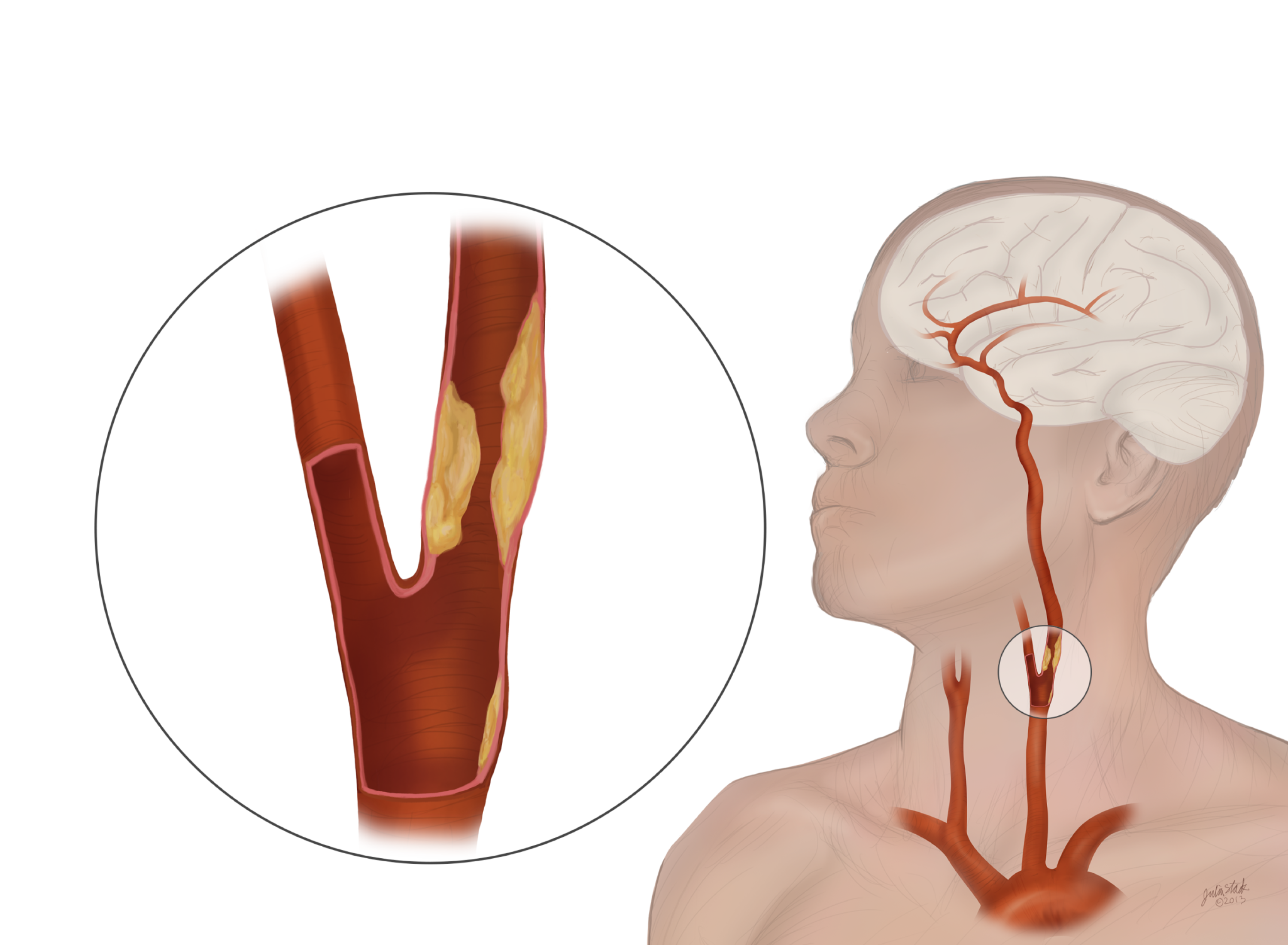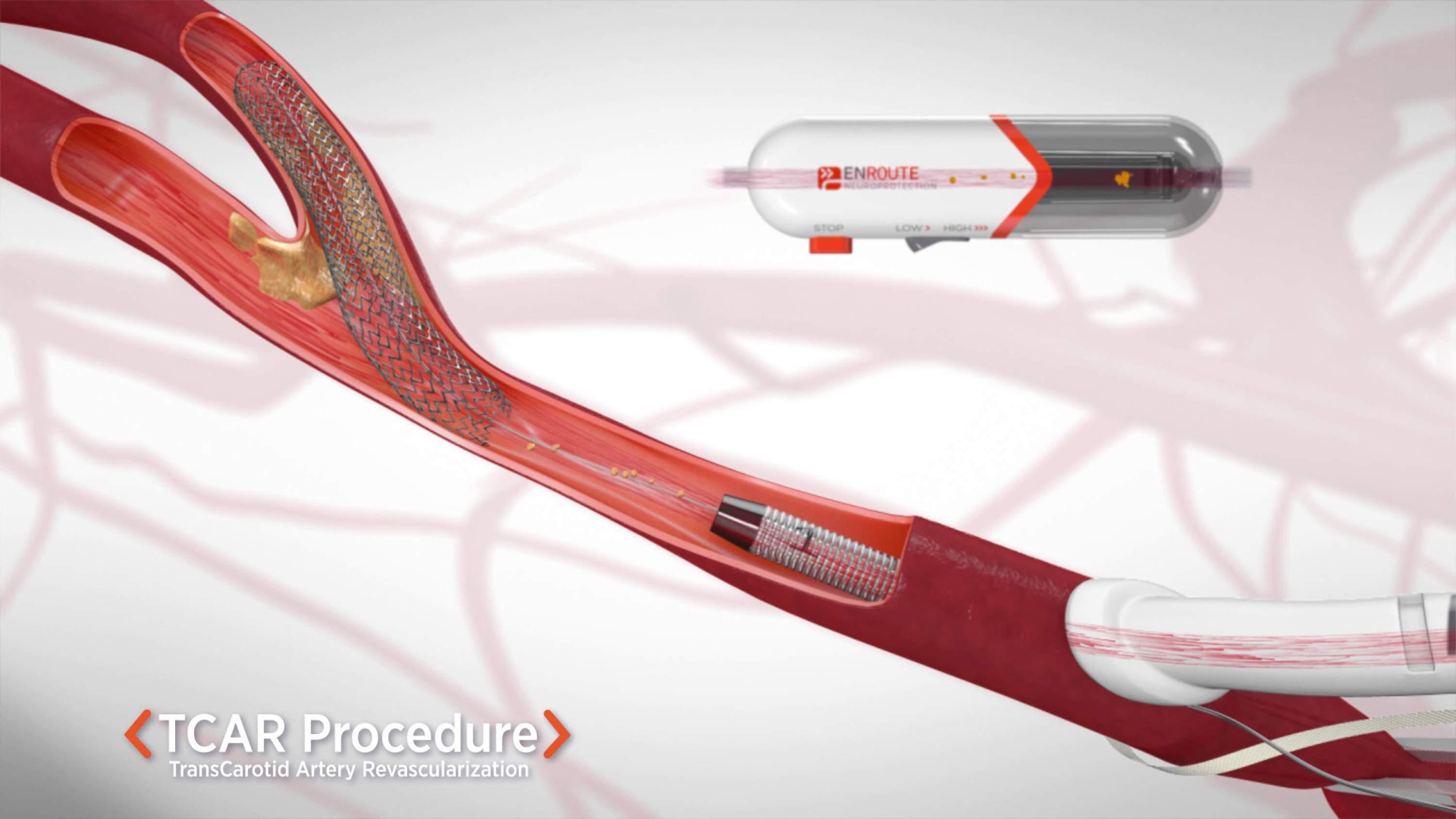Carotid Artery Disease
Carotid artery disease is responsible for up to 1/3rd of all strokes

The carotid arteries are a set of arteries that travel up your neck and deliver blood and oxygen to your brain and head. As we age, our blood vessels build up with fatty deposits, or plaque, which can limit blood flow. This narrowing of blood vessels in the carotid arteries due to plaque is called carotid disease. As carotid arteries narrow due to plaque buildup, a patient becomes at risk for stroke development. A stroke occurs when there is a lack of sufficient blood supply to the brain, or a piece of plaque travels to the brain and blocks smaller vessels. Stroke is the 5th leading cause of death in the United States and reduces mobility and independence in more than half of survivors aged 65 or older.
Risk Factors
Many controllable lifestyle choices and other conditions involving plaque buildup put a patient at risk for carotid disease. Patients with one or more risk factors are eligible for a carotid artery screening study at our practice to assess any presence of disease.
- Smoking
- High Cholesterol
- High Blood Pressure
- Obesity
- History of TIA/Stroke
- Peripheral Arterial Disease
- Heart Disease (Coronary Artery Disease, A-FIB, Heart Attack)
Are you At Risk For Carotid Disease?
Symptoms
Often called the silent killer, the first symptom of patients with carotid disease is often the stroke itself. In addition, patients with carotid disease may experience a “mini-stroke” or TIA. A TIA is when a patient experiences the symptoms of stroke for a brief period of time (less than 24 hours) followed by alleviation of their symptoms. A TIA is often a warning sign for a more disabling stroke down the road. It is important that a patient be taken to the hospital if they are experiencing the symptoms of a TIA or stroke.
Stroke Signs
Know the warning signs and BE FAST
Balance-Watch for sudden loss of balance.
Eyes-Check for vision loss
Face-Look for an uneven smile
Arms-Check if one arm is weak
Speech-Listen for slurred speech
Time-Call 911 right away!
Diagnosis
During a regular physical exam your doctor will listen to your carotid arteries for evidence of a bruit. A bruit is an abnormal rushing sound that may indicate carotid disease. If a bruit is heard, imaging studies are obtained to further assess the extent of carotid disease. However, bruits are not always present when there are blockages, and your doctor may send you for screening carotid tests based on your risk factors for carotid disease.
Here at BEVSA, our doctors and vascular technicians specialize in performing and examining diagnostic tests to assess our patients' carotid disease.
Diagnostic tests for carotid disease include:
Carotid Ultrasound: This is a noninvasive, imaging study performed at our office that uses sound waves to visualize the carotid arteries for narrowing. This is the most common test performed at our office and takes about 15 minutes.
Carotid Angiogram: This is a minimally invasive procedure performed at our office in which a catheter is inserted in the arm or leg to inject contrast dye into the carotid arteries. This test is often performed for patients with high grade carotid artery narrowing to determine if they are a candidate for surgery. The procedure involves local sedation and takes less than an hour.
CT Angiogram Scan: This is an imaging study that combines x-ray technology and contrast use. The dye is injected through a small IV line started in your arm and the test does not require any sedation. This test is usually performed for patients with high grade artery narrowing to determine if they are a candidate for surgery.
Treatment Options for Mild to Moderate Carotid Artery Disease
For patients with mild to moderate carotid artery blockages, our physicians and team at BEVSA work with you to develop a treatment plan to prevent the progression of your disease. It is important to remember that carotid disease does not usually cause symptoms until after significant vessel damage has occurred. Therefore, incorporating these changes are vital even if you are feeling well from a carotid standpoint.
Risk Factor Modification: Tobacco use damages the arterial walls which makes it easier for plaque to build up and cause complications such as stroke. Studies have shown that carotid wall thickening and degree of stenosis increases from never smokers to former smokers to current smokers. In addition, carotid artery stenosis increases as the number of pack years of smoking increases. If you need help quitting smoking, our physicians will help you obtain information on medication, nicotine replacement products, and programs to make it easier
Diet and Activity: It is important to maintain a diet low in saturated fat, cholesterol, and sodium. Foods with these components can elevate cholesterol levels making it more likely for plaque to build up in the carotid artery and cause narrowing. Our physicians will work with you to develop a customized, feasible, exercise plan and dieting. Exercise plans can be as simple as sustained walking, leg cycling or swimming starting at 5-10 minutes per day and slowly progressing to a goal of 30 minutes.
Medication Management: Two of the major risk factors for carotid disease are elevated cholesterol/fat levels and type 2 diabetes. Statins have been shown to manage cholesterol/fat levels, stabilize plaque, and reduce the risk of carotid plaque buildup and stroke. In addition patients with type 2 diabetes should engage in good glycemic control and work with their physician to achieve low levels of A1C. Our physicians will work with you to ensure you are on the proper medication regimen to lessen your risk of carotid disease and stroke development.
Surgical Treatment Options for Severe Carotid Artery Disease
If you have a severe blockage, or have suffered from a TIA or stroke, your physician may recommend surgically removing the blockage to improve blood flow to the brain. Our physicians at BEVSA are highly trained and experienced in traditional surgical and minimally invasive options to treat carotid disease and will work with you to determine which procedure is the best fit.
Carotid Endarterectomy: During a carotid endarterectomy, your surgeon will surgically remove plaque in the carotid artery. This occurs by making an incision down the side of the neck to expose the diseased artery. Once the artery is exposed, the carotid artery is opened and plaque is removed. Afterwards the artery and surrounding tissue is stitched back together. The procedure takes about 2-3 hours at Gates Vascular Institute and most patients are put under general anesthesia and discharged the following day. For more information about carotid endarterectomy, and to hear one of our surgeons explain the procedure, click on the video below.

Transcarotid Artery Revascularization (TCAR): The TCAR procedure is a minimally invasive, carotid stenting procedure for patients who may be at high risk for a traditional open surgical procedure. A small incision is made above the collarbone and a catheter (long tube) is guided into the carotid artery. A stent, which is a metal tube, is placed over the diseased area of the carotid artery to widen the artery and improve circulation. The procedure takes about 2-3 hours at Gates Vascular Institute and most patients are put under general anesthesia and discharged the following day. Our practice at BEVSA is one of the leaders in TCAR procedures in the WNY region and our surgeons have performed over 100 successful surgeries. For more information about TCAR, and to hear one of our surgeons explain the procedure, click on the video below.

Carotid Endarterectomy Procedure
TCAR Procedure
Patient Success Stories
Here at BEVSA, we pride ourselves on engaging with our patient’s stories and feedback. The following stories help highlight how our superior vascular care and compassion translates from our office to improving the everyday lives of our patients. We hope these stories provide comfort to our patients and their families and illustrate how our team at BEVSA goes above and beyond for our patients everyday.
Roger's TCAR Story
After Roger’s sister underwent a carotid surgery with BEVSA, he spoke to his primary care doctor about his concerning family history of carotid disease. Shortly after, testing results indicated that Roger had a very tight narrowing of his carotid artery which put him at high risk of developing a stroke. Roger was then referred to Dr. Noor and our team at BEVSA for an urgent, minimally invasive, carotid stenting procedure called TCAR. Watch the video below to learn about Roger’s journey with carotid disease, and how he was able to get back to the hobbies that he enjoyed.
Denise's Experience with Carotid Surgery
Denise was diagnosed with carotid artery disease which put her at risk for stroke. She was then sent to our practice for evaluation and treatment. Watch the video to learn about Denise's journey with carotid disease at BEVSA and her experience with the carotid endarterectomy procedure.
Frequently Asked Questions
Will I feel any different after a carotid surgery?
For some patients who have a past history of stroke or TIA, carotid surgery can help alleviate symptoms. However, for the majority of patients, carotid procedures are a preventative measure meant to reduce the risk of the patient developing a stroke in the future. Most patients report being back to their usual activity within a few days after the procedure.
Do I need to follow up with my surgeon after carotid surgery?
After your carotid surgery, it is important to continue seeing your vascular surgeon so they can examine your incision site and ultrasound scan your carotid artery to ensure the blockage has resolved. In addition, many patients that have had a carotid procedure also have disease in the other carotid artery which needs continuous monitoring and potential intervention to ensure the patient is at a decreased risk for stroke.
What should I do if I had a TIA and am now feeling better?
Talk to your physician as soon as possible to be evaluated for a potential source of stroke. Part of the workup will likely involve obtaining carotid artery studies. Even though the symptoms have resolved, people who experience a TIA are at an increased risk of developing a stroke within 3 months. Ignoring possible signs of stroke could have deadly consequences.
Treatment Options for Carotid Artery Disease
Carotid Artery Stenting (TCAR)
- Minimally Invasive
- Carotid Stent Placement
- Stroke Prevention